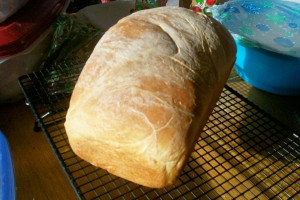I can make my standard sandwich bread with my eyes closed. I love this bread, and acquired the recipe from my trusty old Joy of Cooking- one of the first cookbooks my mom bought for me. It’s become the standard by which I measure all homemade bread, yet there are a few things about it that has kept me looking for more. One is that it deteriorates in quality really quickly. It’s best eaten the first day it is made, good for sandwiches the second day, but beyond that it’s good for grilled cheese or toast only. The second thing I have been musing about removing from the bread recipe is the milk. Now, I agree that the milk enriches the bread with added protein and nutrients, but there are times where I am trying to make a gallon of milk last a few more days, and I hate adding that 1 cup of milk to the bread. Powdered milk has never been a solution for me, as it’s pricey and I’ve heard such conflicting information about using it.
In all truth, what I’ve really been wanting was to find a way to turn delicious white sandwich bread into a vegan option. I eat vegan from time to time, and a slice of toast with nut butter makes a great breakfast when I’m eating that way. There’s nothing worse than commiting to eating vegan for a week and realizing halfway through your sandwich or piece of toast that the bread you are eating contains milk or butter.
I was flipping through one of my Amish cookbooks and looking at the breads. This happened to be the same book I found the Oatmeal Bread in, and sure enough, there was a recipe for plain old white bread that made two loaves. Two loaves is a must- if I’m going to go to the trouble to bake bread, it best make more than one loaf! I read through the recipe- the fact that there was no milk intrigued me- would the bread suffer from it’s omission? I put a batch together, but as I did so, it occurred to me that 1/3 cup of sugar was a lot of sugar. The finished bread had an amazing texture! Even better, it was still soft and delicious the third day after baking. However, it was really sweet, and we didn’t even really want to finish that second loaf.
So I’ve been tweaking and playing around, and yesterday I perfected the recipe. It’s perfect. It makes a great white sandwich bread that is soft and chewy, and it maintains a great texture for three full days. I have settled on honey as my desired sweetener- I am sure you can use sugar instead if you’d like, but we thought the addition of honey gave the bread a depth in flavor. ( I realize that the honey actually makes the bread non-vegan for someone who is a vegan in every facet of life, but for myself who chooses to eat like a vegan from time to time, I’m good with the honey. ) The recipe also calls for 2 1/2 tablespoons of shortening. I use my organic palm shortening, but I think you can easily sub in whatever fat you would like. The un-tweaked recipe called for it to be melted, so even oil would be a fine substitution. I found that the palm shortening didn’t need to be melted first and could simply be worked into the dough as is.
This is my new standard sandwich bread. It’s really not that different from my old recipe, but the improvements seem to make a huge difference! I do plan to play with it just a touch more by swapping out some of the white bread flour for whole wheat flour and finding a good way to do a whole wheat loaf that way. I need to refresh my whole wheat flour supply, and then I’ll be doing that. As an added bonus, my previous favorite bread called for two rises plus a third rise in the bread pans. This recipe skips the second rise- the rising does take a little longer, but it is well worth it.
Basic White Bread
makes 2 loaves of bread.
1/4 cup warm water 2 1/4 teaspoons instant yeast (or 1 packet) 2 tablespoons honey 2 1/2 tablespoons organic palm shortening 2 teaspoons salt 2 cups warm water 5-6 cups bread flourIn a large mixing bowl, combine 1/4 cup warm water and the yeast. Let sit for 5 minutes. Add the honey, shortening, salt and water, and mix well. Add 3 cups of the bread flour and stir until the dough is smooth.
Now start working in the flour 1/2 cup at a time. Once it become difficult to work with a spoon, turn it out onto a floured surface and knead by hand, adding flour as needed. You’ll want to knead for 7-10 minutes total, or until the dough is smooth and no longer sticky. (If you use sugar instead of honey, this will take less flour.)
Place the dough in a bowl that has been oiled and turn to coat. Cover the dough and let rise for 2 hours.
Grease two loaf pans with your preferred grease.
Turn the dough out onto a lightly floured surface. Divide the bread in half, and roll each half into a loaf. Once shaped, place the loaves in the prepared loaf pans.
Cover, let rise for 1 1/2 hours.
Preheat oven to 375ºF. Place the bread in the hot oven and bake for 30-35 minutes or until golden brown.
Cool completely on a rack before slicing.
